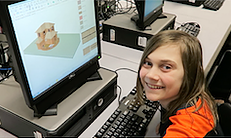Wayne Kroeplin is an experienced teacher whose goal is to help students become innovative and creative thinkers, especially in the realm of science. He has created two courses thus far, Thinking Like an Engineer and Thinking Like an Architect. Thinking Like a Carpenter is coming soon. Courses are presented online and require a high speed internet connection.
These are nothing like typical science courses. They walk students through a series of learning experiences. Kroeplin sometimes appears as a talking head, but there are always graphics, videos or some other visual to keep students’ interest. Videos are never just for entertainment—they always advance the lesson content even though they are often entertaining as well. Every once in a while there’s a short automated quiz, but the courses are more about inspiration and concepts rather than memorization for the quizzes so these are not that difficult. Challenge Activities in the different course modules have students tackle projects that will help them apply what they are learning.
I worked through Thinking Like an Engineer for this review. The course is presented in sections: Introduction to Engineering, Introduction to 3D Design, Engineering Roller Coasters, Engineering Bridges, Nano Engineering, and Thinking Like an Engineer.
In Introduction to Engineering, Kroeplin introduces students to many different types of careers in engineering. He presents a number of engineering challenges facing the world such as making solar energy more affordable or securing cyberspace. These are presented to the student as possible “engineering” or “innovating” challenges that they actually might want to tackle. Students are continually encouraged with the idea that THEY might be the one to come up with a solution. One of the Challenge Activities for this part of the course is to make their own water filtration system.
In the section of course on roller coasters, students learn about the entire process for creating a roller coaster from designing the coaster and surveying the land through construction. It introduces science concepts such as potential and kinetic energy, gravity, g-forces, and friction. Kroeplin brings in some serious math, explaining the formulas for potential energy, kinetic energy, and velocity. However, he continually simplifies and explains so that students are not overwhelmed. At this point, he’s showing how engineers use math to determine the design of a roller coaster, but he’s not expecting students to master the math.
One large challenge project for this module has students build a roller coaster with paper, scissors, and tape. Specs for the project are on a printable page along with a testing/scoring guide. Other files have detailed directions on how to create various components such as beams and columns, tracks, curves, and funnels. Another file has templates for all of these components. Older students should print out the files on “Calculating Potential Energy and Kinetic Energy of a Rolling Marble” and “Calculating Average Speed of a Rolling Marble” and do the math calculations. The project is like the marble raceways that you can buy although, if done well, the student project will include loops and creative elements, and it might be very tall.
The Engineering Bridges section of the course takes a very practical look at what it takes to build a bridge, including some of the math applications. It uses the disastrous Tacoma Narrows Bridge—this bridge is also know as Gallopin' Gertie—as a sort of case study, sometimes contrasting it with the successful Golden Gate Bridge. This module stresses the physics involved such as tension, compression, and aerodynamics. Kroeplin explains briefly how math (algebra, trigonometry, and calculus) is used in bridge engineering.
The first challenge for this module is for students to build their own suspension bridge with cardboard, string, popsicle sticks, and masking tape, then test it by loading it with heavy metal washers or something similar. The final challenge is to download the included bridge construction software and design their own bridge.
Lessons frequently include links to videos for students to watch. Many of these are amazing. For example, in the roller coaster lessons, there’s a video of a daredevil who wants to find out if it’s possible to ride a roller coaster track on roller skates—(spoiler alert: He does it without killing himself!) Historic footage of the Tacoma Narrows Bridge’s collapse provides a very memorable video illustration of poor aerodynamics in the bridge’s design.
The Thinking Like an Architect bundle includes architectural design software and lots of engaging, hands-on activities to give students continued practice thinking like an innovator, but this time through the eyes of an architect.
The challenge projects in both courses are fabulous. Students are likely to really enjoy them. I recommend trying to have at least a couple of students work through these courses at the same time so that they can compete with some of their projects.
Summary
These courses are great for homeschoolers looking for ways to expand STEM (science, technology, engineering, and math) education for junior and senior high students. Each course provides about 30 hours of learning so they might be used as components of science courses (about one quarter of the school year per course) or as elective courses worth one-fourth credit each.








